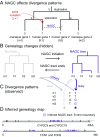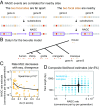Frequent nonallelic gene conversion on the human lineage and its effect on the divergence of gene duplicates
- PMID: 29138319
- PMCID: PMC5715747
- DOI: 10.1073/pnas.1708151114
Frequent nonallelic gene conversion on the human lineage and its effect on the divergence of gene duplicates
Abstract
Gene conversion is the copying of a genetic sequence from a "donor" region to an "acceptor." In nonallelic gene conversion (NAGC), the donor and the acceptor are at distinct genetic loci. Despite the role NAGC plays in various genetic diseases and the concerted evolution of gene families, the parameters that govern NAGC are not well characterized. Here, we survey duplicate gene families and identify converted tracts in 46% of them. These conversions reflect a large GC bias of NAGC. We develop a sequence evolution model that leverages substantially more information in duplicate sequences than used by previous methods and use it to estimate the parameters that govern NAGC in humans: a mean converted tract length of 250 bp and a probability of [Formula: see text] per generation for a nucleotide to be converted (an order of magnitude higher than the point mutation rate). Despite this high baseline rate, we show that NAGC slows down as duplicate sequences diverge-until an eventual "escape" of the sequences from its influence. As a result, NAGC has a small average effect on the sequence divergence of duplicates. This work improves our understanding of the NAGC mechanism and the role that it plays in the evolution of gene duplicates.
Keywords: GC bias; gene conversion; gene duplicates; mutation rate; sequence evolution.
Conflict of interest statement
The authors declare no conflict of interest.
Figures




Similar articles
-
Linking great apes genome evolution across time scales using polymorphism-aware phylogenetic models.Mol Biol Evol. 2013 Oct;30(10):2249-62. doi: 10.1093/molbev/mst131. Epub 2013 Aug 1. Mol Biol Evol. 2013. PMID: 23906727 Free PMC article.
-
The sequence of the gorilla fetal globin genes: evidence for multiple gene conversions in human evolution.Mol Biol Evol. 1984 Sep;1(5):371-89. doi: 10.1093/oxfordjournals.molbev.a040325. Mol Biol Evol. 1984. PMID: 6599972
-
De Novo Genes Arise at a Slow but Steady Rate along the Primate Lineage and Have Been Subject to Incomplete Lineage Sorting.Genome Biol Evol. 2016 Apr 25;8(4):1222-32. doi: 10.1093/gbe/evw074. Genome Biol Evol. 2016. PMID: 27056411 Free PMC article.
-
Chimpanzee fetal G gamma and A gamma globin gene nucleotide sequences provide further evidence of gene conversions in hominine evolution.Mol Biol Evol. 1985 Sep;2(5):370-89. doi: 10.1093/oxfordjournals.molbev.a040357. Mol Biol Evol. 1985. PMID: 3870867
-
Evolution and demography of the great apes.Curr Opin Genet Dev. 2016 Dec;41:124-129. doi: 10.1016/j.gde.2016.09.005. Epub 2016 Oct 4. Curr Opin Genet Dev. 2016. PMID: 27716526 Review.
Cited by
-
Demographic inference from multiple whole genomes using a particle filter for continuous Markov jump processes.PLoS One. 2021 Mar 2;16(3):e0247647. doi: 10.1371/journal.pone.0247647. eCollection 2021. PLoS One. 2021. PMID: 33651801 Free PMC article.
-
Ectopic Gene Conversion Causing Quantitative Trait Variation.Mol Biol Evol. 2025 Apr 30;42(5):msaf086. doi: 10.1093/molbev/msaf086. Mol Biol Evol. 2025. PMID: 40200803 Free PMC article.
-
Estimating Gene Conversion Tract Length and Rate From PacBio HiFi Data.Mol Biol Evol. 2025 Feb 3;42(2):msaf019. doi: 10.1093/molbev/msaf019. Mol Biol Evol. 2025. PMID: 39982809 Free PMC article.
-
Phylogenetic and Molecular Analyses Identify SNORD116 Targets Involved in the Prader-Willi Syndrome.Mol Biol Evol. 2022 Jan 7;39(1):msab348. doi: 10.1093/molbev/msab348. Mol Biol Evol. 2022. PMID: 34893870 Free PMC article.
-
Increased mutation and gene conversion within human segmental duplications.Nature. 2023 May;617(7960):325-334. doi: 10.1038/s41586-023-05895-y. Epub 2023 May 10. Nature. 2023. PMID: 37165237 Free PMC article.
References
-
- Chen JM, Cooper DN, Chuzhanova N, Férec C, Patrinos GP. Gene conversion: Mechanisms, evolution and human disease. Nat Rev Genet. 2007;8:762–775. - PubMed
-
- Innan H, Kondrashov F. The evolution of gene duplications: Classifying and distinguishing between models. Nat Rev Genet. 2010;11:97–108. - PubMed
-
- Bischoff J, et al. Genome-wide identification of pseudogenes capable of disease-causing gene conversion. Hum Mutat. 2006;27:545–552. - PubMed
Publication types
MeSH terms
Grants and funding
LinkOut - more resources
Full Text Sources
Other Literature Sources
Research Materials
Miscellaneous

